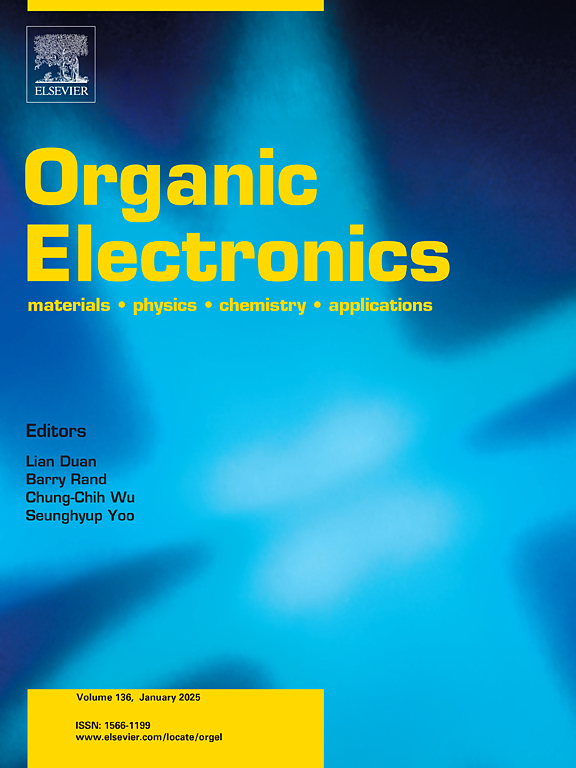Approaches for white organic light-emitting diode via solution-processed blue and yellow TADF emitters: Charge balance and host-guest interactions in a single emission layer
IF 2.6
4区 工程技术
Q3 MATERIALS SCIENCE, MULTIDISCIPLINARY
引用次数: 0
Abstract
- Download: Download high-res image (233KB)
- Download: Download full-size image

通过溶液处理的蓝色和黄色TADF发射器制备白色有机发光二极管的方法:单发射层中的电荷平衡和主客体相互作用
下载:下载高清图片下载:下载全尺寸图片尽管oled如今已广泛应用于显示技术设备,但由于成本效益问题(主要与设备制造有关),其在室内照明中的应用仍然是一个挑战。在此意义上,本研究探讨了溶液处理oled中蓝色发射TADF (DMOC-DPS)和黄色发射TADF (TXO-TPA)化合物的优化,以实现双有机层器件中高效的白光发射。研究了四种不同的主体材料,旨在平衡空穴和电子的电荷迁移率。使用的宿主材料包括(以%wt计)1:1的mCP和DPEPO混合物(HOST1), 3:2的PVK和DPEPO混合物(HOST2), 3:2的PVK和mCP混合物(HOST3),以及3:2的PVK和丁基pbd混合物(HOST4)。溶液处理oled的实验结果表明,DMOC-DPS主要是一种空穴输运材料,而HOST1和HOST4等寄主则主要是n型寄主,以最平衡的电荷迁移率生成效率最高的白色oled。经过结构优化,HOST4和HOST1的EQE分别达到6.43%和6.06%,亮度为2621 cd/m2(未集成),亮度为1986 cd/m2。发射特性受主体材料特性的影响,蓝色和黄色的发射被微调以产生互补色。这项研究强调了电荷迁移平衡在发射层中的关键作用,并展示了独立优化蓝色和黄色TADF组件用于适合室内照明应用的高性能WOLEDs的潜力。
本文章由计算机程序翻译,如有差异,请以英文原文为准。
求助全文
约1分钟内获得全文
求助全文
来源期刊

Organic Electronics
工程技术-材料科学:综合
CiteScore
6.60
自引率
6.20%
发文量
238
审稿时长
44 days
期刊介绍:
Organic Electronics is a journal whose primary interdisciplinary focus is on materials and phenomena related to organic devices such as light emitting diodes, thin film transistors, photovoltaic cells, sensors, memories, etc.
Papers suitable for publication in this journal cover such topics as photoconductive and electronic properties of organic materials, thin film structures and characterization in the context of organic devices, charge and exciton transport, organic electronic and optoelectronic devices.
 求助内容:
求助内容: 应助结果提醒方式:
应助结果提醒方式:


